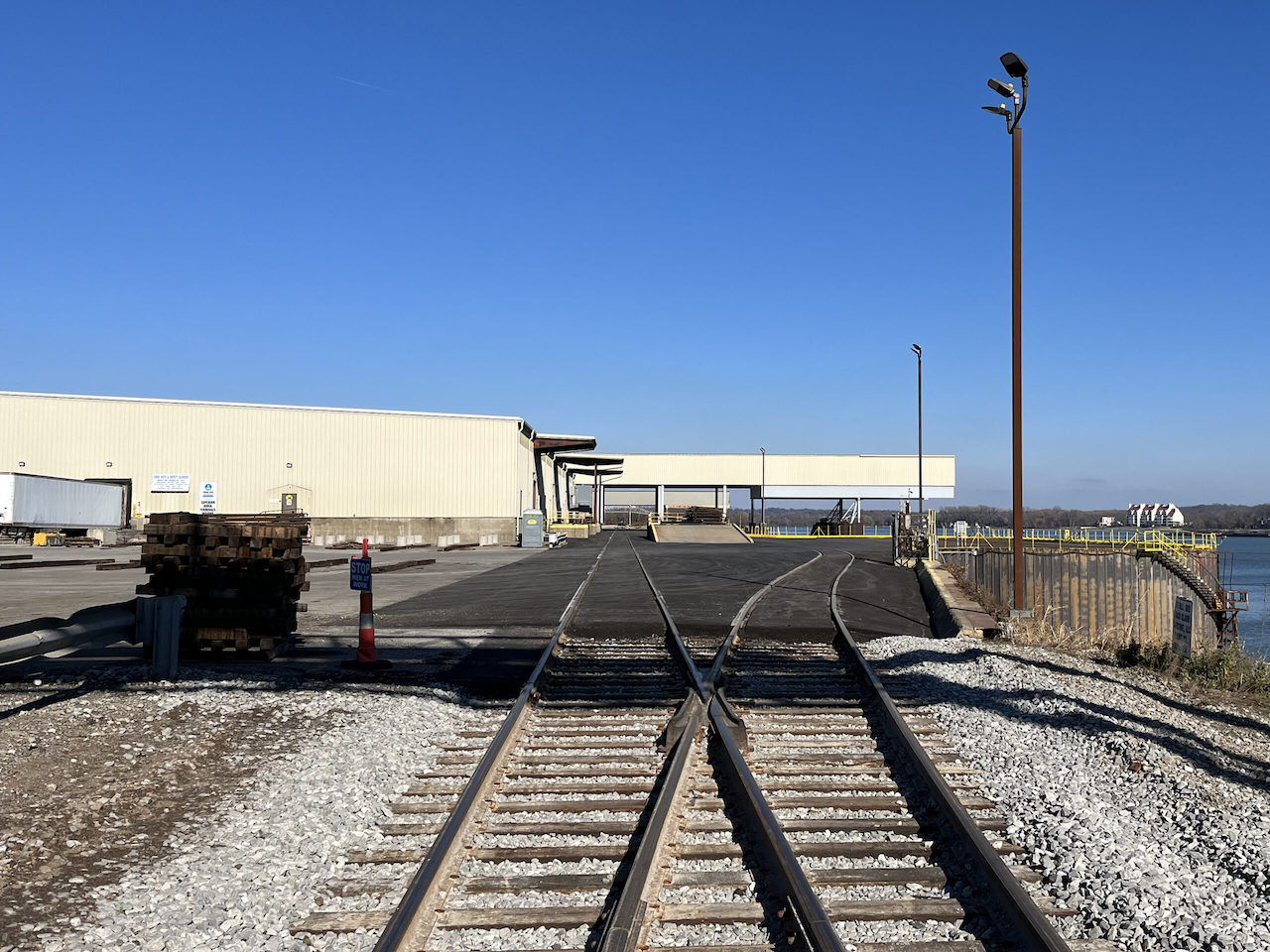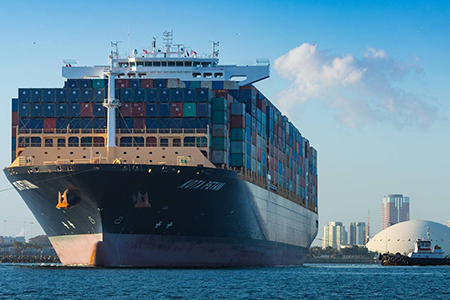
Intermodal Briefs: Ports of Indiana/MG Rail, Port of Los Angeles, POLB, Saguenay Port Authority
Written by Carolina Worrell, Senior Editor
Ports of Indiana photo
Ports of Indiana and MG Rail complete $1.1 million in road and rail improvements at Jeffersonville Port. Also, November cargo volume increases at Port of Los Angeles and the Port of Long Beach (POLB); and the Saguenay Port Authority receives $111.1 million to support conveyor planning.
Ports of Indiana/MG Rail
Infrastructure investments surpassing $1.1 million were recently completed at Ports of Indiana-Jeffersonville through a yearlong series of road and rail projects by Ports of Indiana and MG Rail, the port’s rail switcher.
Port capital projects included pavement work, milling and repaving nearly 94,500 square feet of dockside transload area—or an area greater than one-and-a-half football fields.
MG Rail’s rail work included preventative maintenance on rail track along the existing main line and within the port’s switching yard, and rail upgrades along the waterfront.
To maintain top rail right-of-way standards, MG Rail renewed more than seven miles of track along with 24 switches. Crews also installed 1,500 tons of ballast and nearly 1,400 crossties throughout the port.

Ports of Indiana and MG Rail partnered to complete upgrades to the dockside area with careful coordination. Once port contractors removed the old asphalt, rail crews went to work replacing 1,200 feet of worn 105-pound rail with newer 115-pound rail that easily accommodates modern 286,000-pound railcars carrying steel, grain and other cargos.
“We strive to maintain first-class infrastructure and facilities to support the economic growth of our customers and the regional economy,” said Port Director George Ott. “Ports of Indiana-Jeffersonville and MG Rail partner to provide a vital link in the supply chain for numerous multimodal companies throughout the Midwest.”
“Maintaining safe and efficient operations is critical to the success of our railroad and for the businesses located at the port,” said Chuck Long, a representative of Consolidated Grain and Barge Co. (CGB). MG Rail is owned by CGB, which operates a large grain elevator and bulk cargo terminal at the port. “We take great pride in our partnership with Ports of Indiana as we both work to provide the infrastructure and services that local businesses need to survive and grow well into the future.”
The Jeffersonville Port opened in 1985 and generates $2.5 billion in annual economic impacts for the regional economy.
Port of Los Angeles
The Port of Los Angeles on Dec. 13 reported that cargo volume at the Port increased for the fourth consecutive month compared to the previous year. The Port processed 763,262 Twenty-Foot Equivalent Units (TEUs) in November, a 19% improvement compared to last year.
November 2023 loaded imports landed at 384,619 TEUs, an increase of 25% compared to the previous year, according to the Port of Los Angeles. Loaded exports came in at 111,755 TEUs, an increase of 24% compared to 2022. Empty containers totaled 266,888 TEUs, a 10% increase compared to last year.
“Our year-end growth reflects the strength of the U.S. economy powered by the American consumer,” said Port of Los Angeles Executive Director Gene Seroka at a media briefing. “Black Friday and Cyber Monday sales were strong, and the forecast for overall holiday sales is 3 to 4% above last year, another high mark.
“Thanks to the outstanding efforts of our dockworkers and other stakeholders, we’ve gained market share in recent months,” Seroka added. “We’ll continue those efforts into 2024 as we work toward maximizing our operational efficiencies and decarbonizing our port complex.”
Eleven months into 2023, the Port has processed 7,887,162 TEUs, 14% less than the same period last year. Current and historical cargo data, including fiscal year-end totals, are available here.
POLB
Shippers continued to reposition cargo back to West Coast seaports in November, lifting trade for a third consecutive month at POLB, the Port reported on Dec. 13.
Dockworkers and terminal operators moved 731,033 TEUs last month, a 24.2% increase from November 2022. Imports rose 37% to 355,339 TEUs and exports declined 13% to 108,798 TEUs. Empty containers moved through the Port were up 30.6% to 266,896 TEUs.
The Port has moved 7,308,848 TEUs during the first 11 months of 2023, down 14.9% from the same period last year. Cargo flows this year have been approximately on pace with pre-pandemic levels when POLB moved more than 6.96 million TEUs through November 2019.

“We are recapturing market share, online shopping is on the rise and retailers are keeping the shelves stocked to meet rising consumer demand for the holidays,” said POLB CEO Mario Cordero. “We remain optimistic as cargo returns to this critical gateway for trans-Pacific trade.”
“We appreciate the outstanding work of our waterfront workforce and terminal operators who are moving goods to ensure consumers are able to purchase gifts during the holiday season,” said Long Beach Harbor Commission President Bobby Olvera Jr. “We plan to continue delivering top-notch customer service and building for a sustainable future into the new year.”
Complete cargo numbers are available here.
Saguenay Port Authority
Transport Canada recently announced that the government of Canada and Quebec are providing $111.2 million to the Saguenay Port Authority for constructing a Mechanized Multi-User Bulk Transport System.
According to Transport Canada, this conveyor, run entirely by electricity, will connect the Port to industrial storage spaces and rail yards located in Saguenay’s industrial port zone (IP zone). It is anticipated to be in service in 2025.
The Minister of Economy, Innovation and Energy and the Minister Responsible for the Metropolis and the Montréal Region, Pierre Fitzgibbon, made the announcement on Dec. 11, along with the Minister of Municipal Affairs and the Minister Responsible for the Saguenay–Lac-Saint-Jean Region, Andrée Laforest, and the member for Dubuc and Parliamentary Assistant to the Minister of Tourism, François Tremblay.
The Government of Canada contributed $55.2 million to the Saguenay Port Authority. The Government of Quebec, meanwhile, offered a loan, repayable through fees, of a maximum of $36.8 million from the Department of Economy, Innovation and Energy, as well as $19.2 million in financial aid from the Department of Transport and Sustainable Mobility.
The two levels of government, Transport Canada says, “reaffirm that the Port of Saguenay represents a central economic driver for development in the region of Saguenay–Lac-Saint-Jean.”
The Saguenay IP zone was identified as a priority by the Minister of Economy, Innovation and Energy since it has:
- “Large tracts of land available in an industrial zone.
- “Multimodal logistical infrastructure like rail access, the highway system, the deep-water port and this conveyor.
- “A qualified workforce in a university city.”
In addition to the $111.2 million for the construction of a Mechanized Multi-User Bulk Transport System, Quebec previously committed $105.5 million to establish multi-use infrastructure for the Saguenay IP zone and also recently announced $20 million for enlarging the Marcel-Dionne Wharf.
“Today, we continue to invest in the Port of Saguenay to consolidate an important commercial corridor and encourage the creation of quality jobs for the workers of Saguenay,” said Minister of Transport and Quebec Lieutenant Pablo Rodriguez. A robust supply chain benefits all Canadians, and with our investments, we continue to forge ahead with a green shift for our Maritime shipping routes.”



